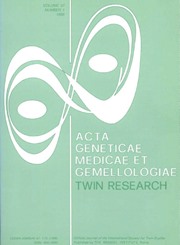No CrossRef data available.
Article contents
Asynchronous Replication Patterns of Imprinted Genes in Triploid Cells
Published online by Cambridge University Press: 01 August 2014
Extract
Several unique features distinguish imprinted from nonimprinted genes, including the unusual replication behavior the unequal methylation and the differential expression of imprinted alleles [1]. The replication timing in S phase of the two homologous alleles of a normal, nonimprinted gene is highly synchronous [2, 3]. Housekeeping genes replicate early, constitutive heterochromatic regions replicate late and tissue-specific genes replicate earlier when they are expressed than when they are not [2-4]. In contrast, imprinted genes which, by definition, display allele-specific expression replicate asynchronously [2-5].
The relative order of replication of homologous alleles as well as that of different loci can be elegantly compared with fluorescence in situ hybridization (FISH) on interphase nuclei [2-5]. Unreplicated DNA segments give singlet hybridization signals in normal diploid cells, while replicated loci are characterized by doublets. The distribution of these two patterns can be used to determine the S phase replication time of any DNA sequence. Moreover, determination of the singlet/doublet ratio allows a good estimation of the degree of replication asynchrony of two homologous alleles [2-5].
Using cell lines with deletions, disomies or associated FISH-detectable centromeric satellite polymorphisms, Kitsberg et al. [4] found that the paternal allele was the early replicating one in all the imprinted genes which they had analyzed. Subsequently, however, Knoll et al. [5] detected genes in the imprinted Prader-Willi region on chromosome 15, which also displayed other patterns. Therefore, it seems necessary to specify the relative timing of maternally and paternally derived alleles for each individual asynchronously replicating gene. Unfortunately, this is so far only feasible with a very restricted number of sequences.
Information
- Type
- Research Article
- Information
- Acta geneticae medicae et gemellologiae: twin research , Volume 45 , Issue 1-2 , April 1996 , pp. 207 - 212
- Copyright
- Copyright © The International Society for Twin Studies 1996

